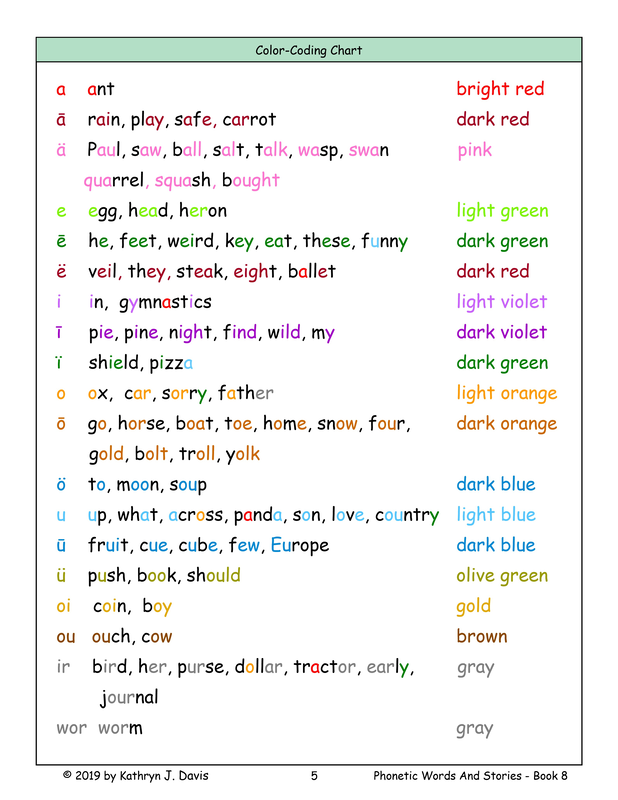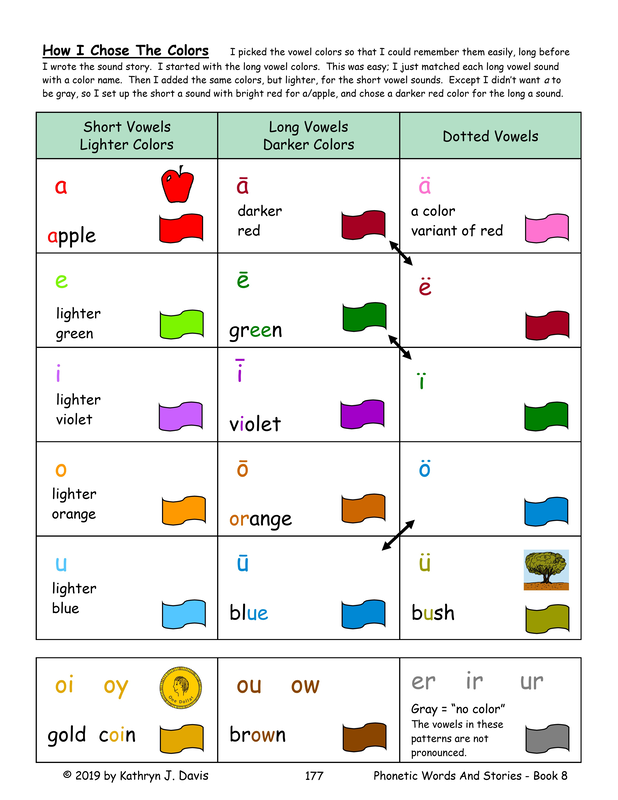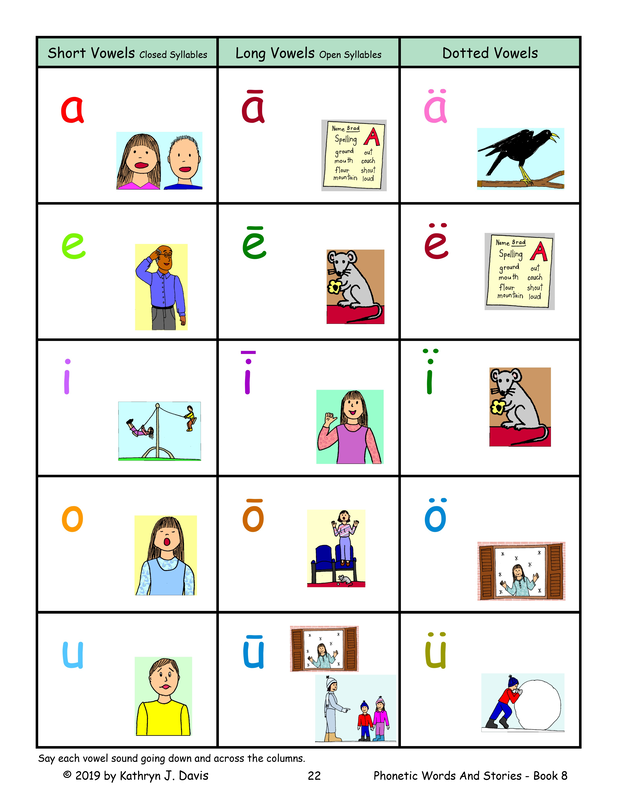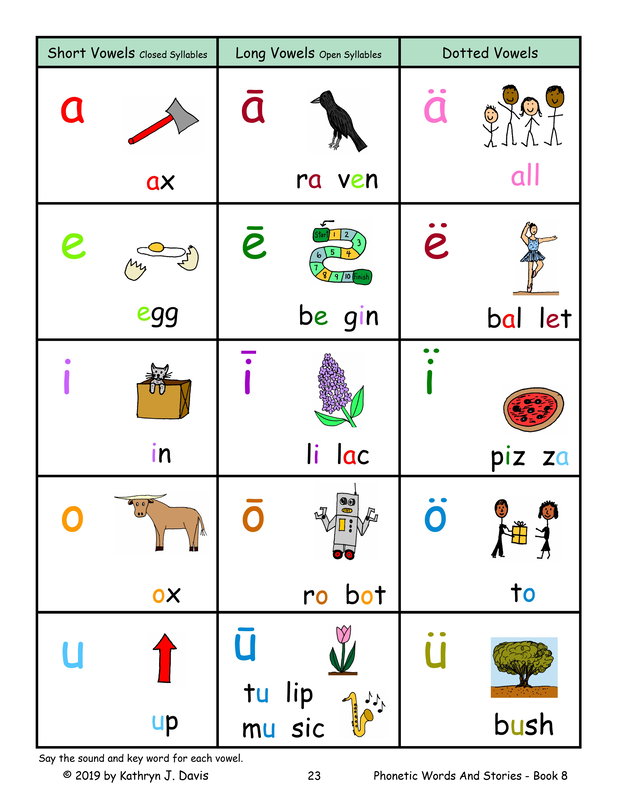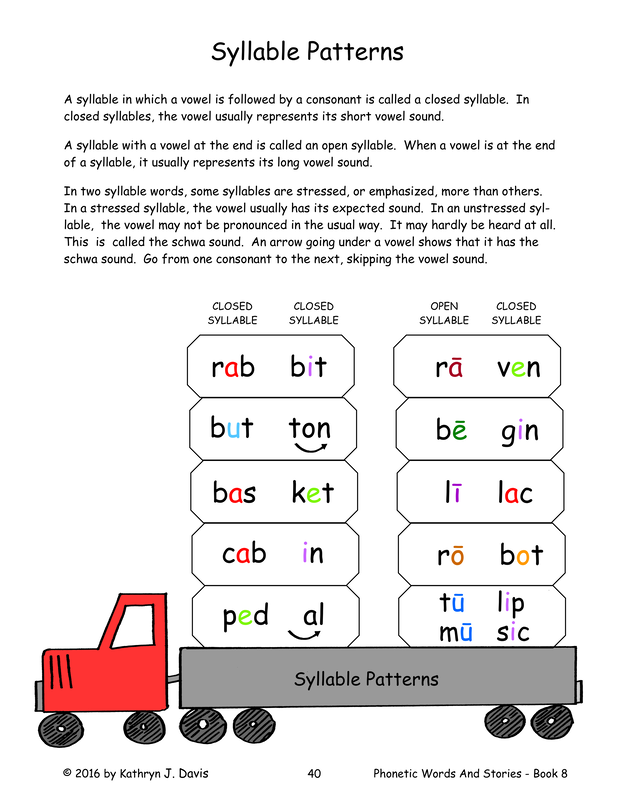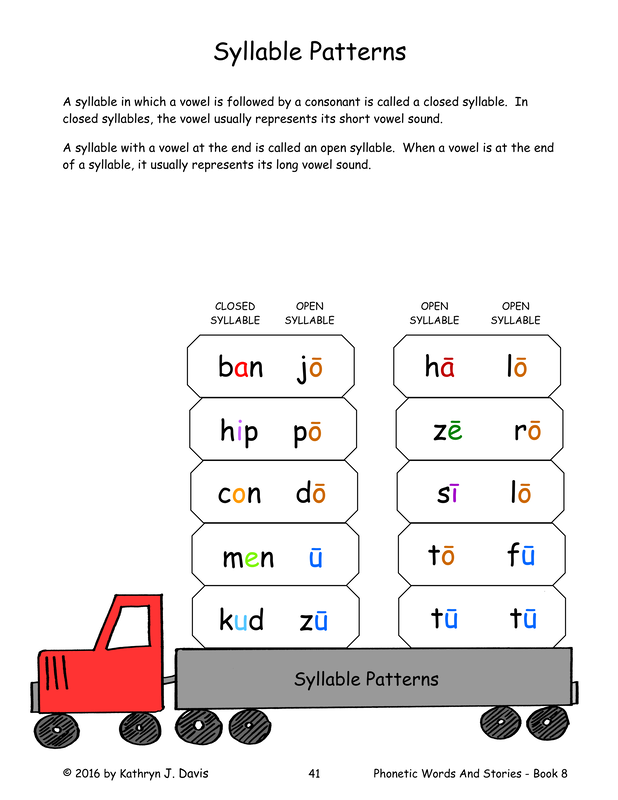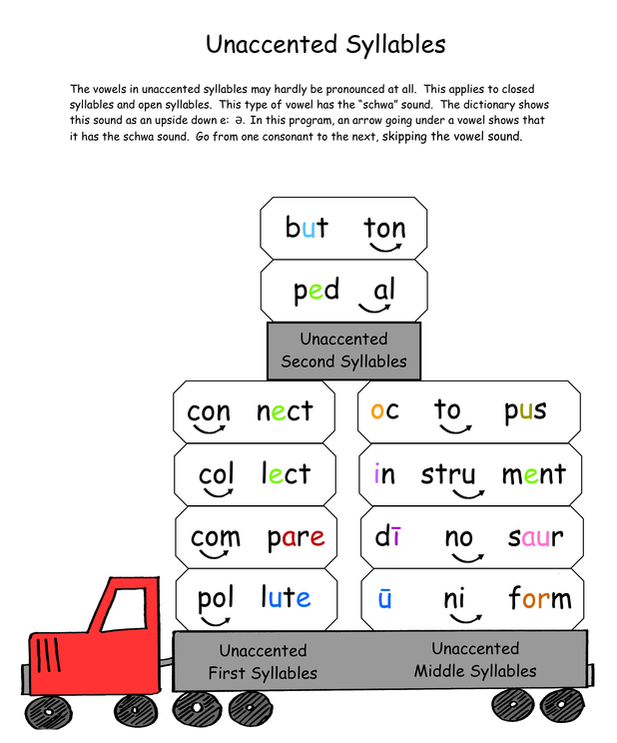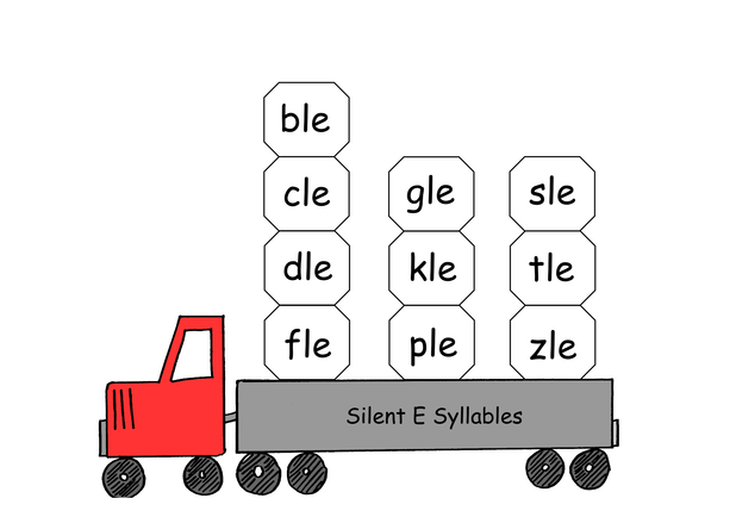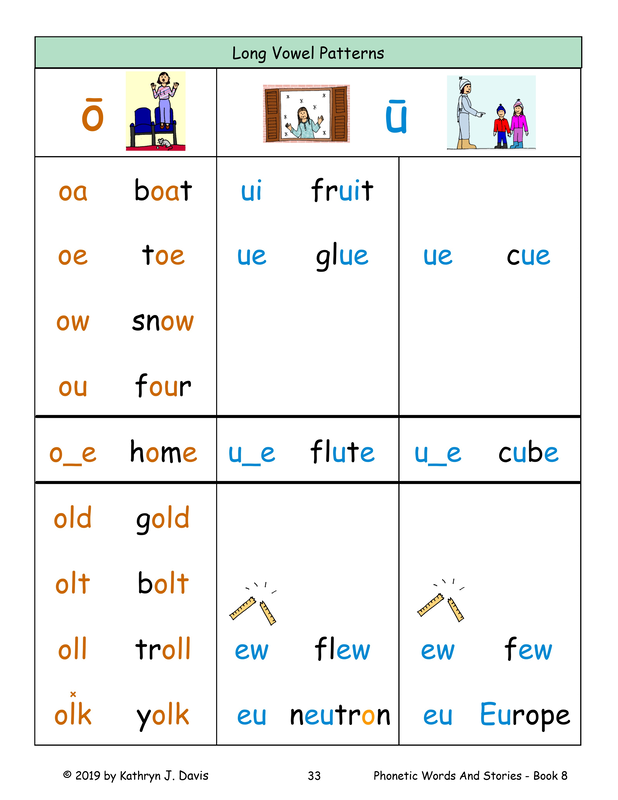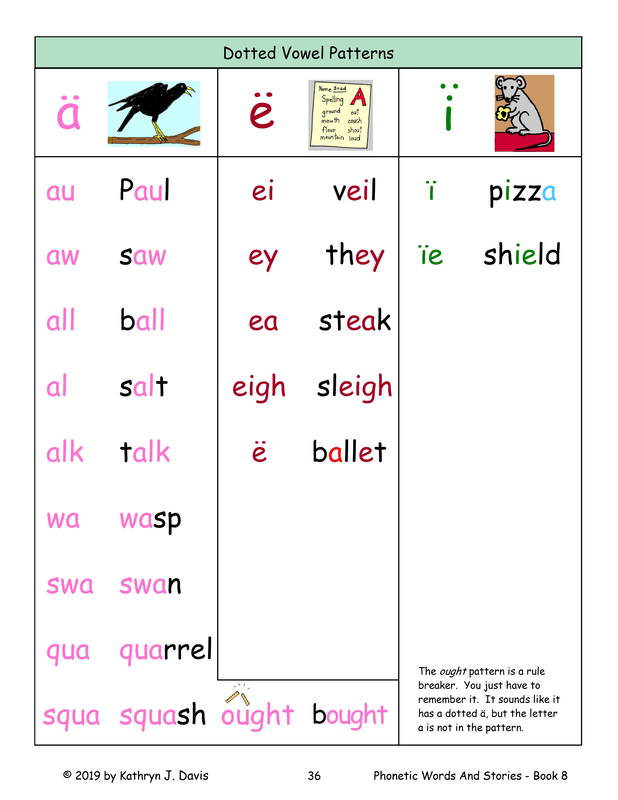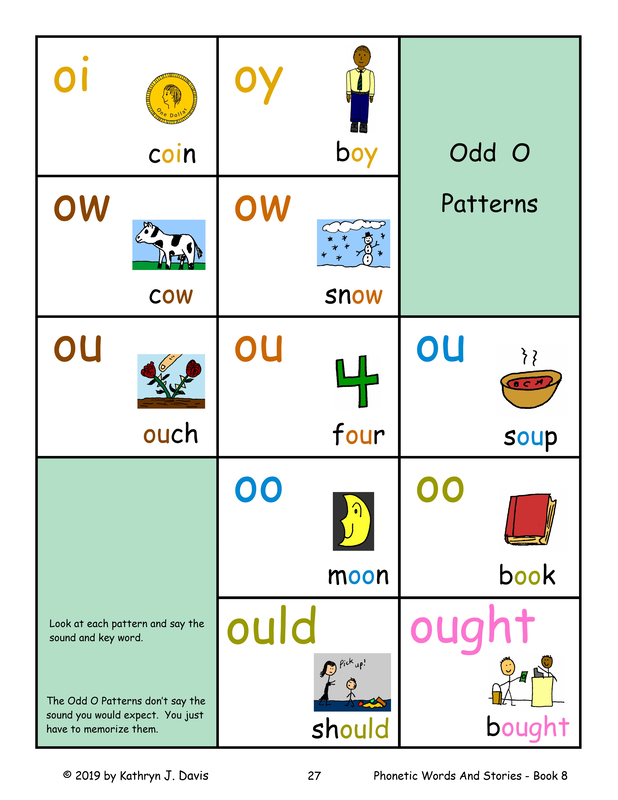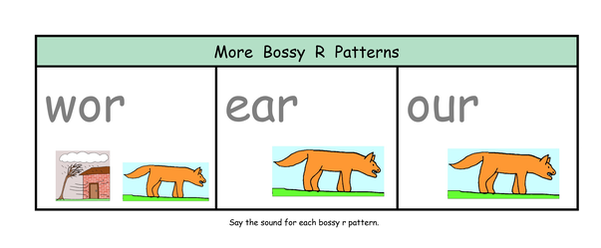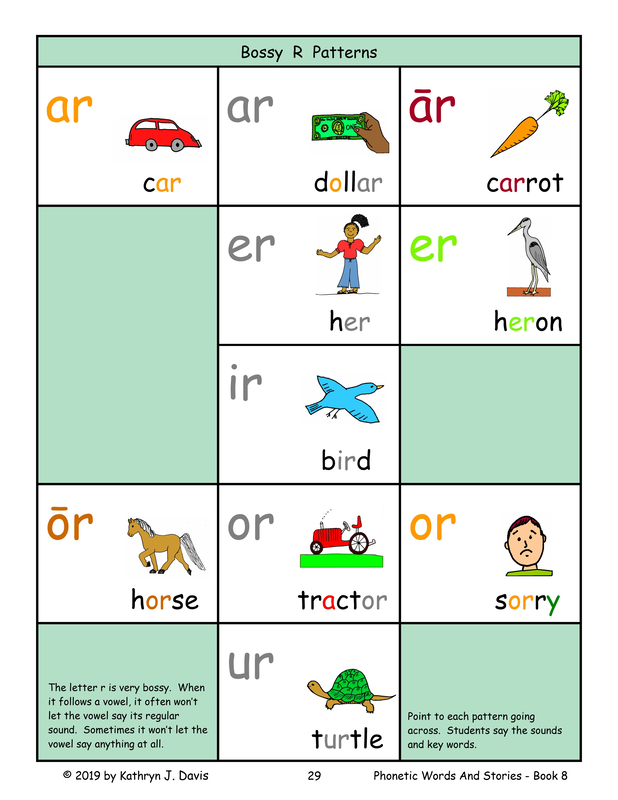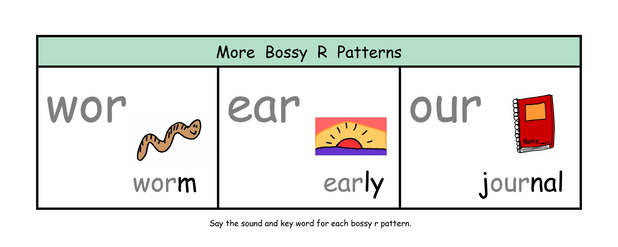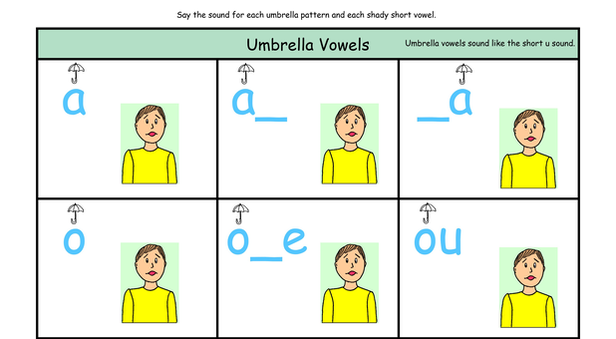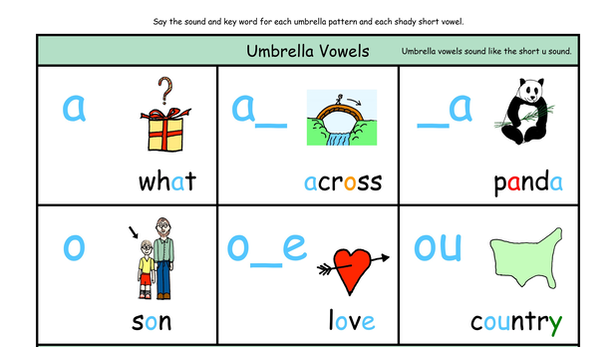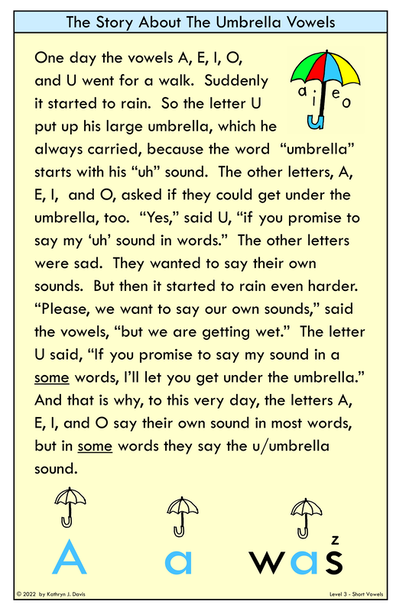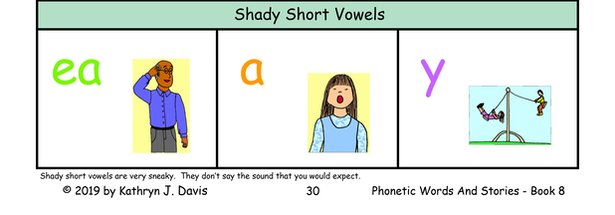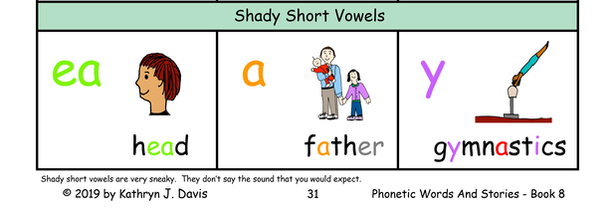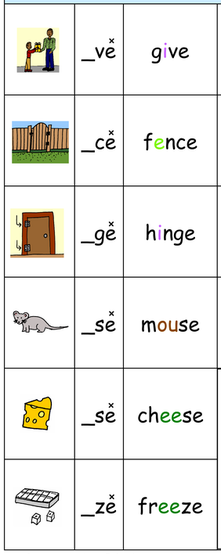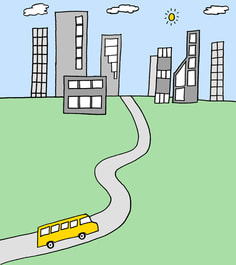Understanding Vowels
The Sound City Reading program teaches the vowels and vowel patterns one at a time so that students can become very familiar with one pattern before going on to the next. Patterns that are similar are taught one after the other, so that students can see the similarities between them.
Students practice saying the vowel sounds they have learned from sound charts and flashcards daily. They also write the patterns they have learned, when given the sounds by the teacher. After learning a new pattern, students spell and read words with the pattern. This step by step process makes learning the vowels much easier.
To hear the vowel sounds from the sound story and sound charts in the student books, click on the audio and video menu headings.
Do not be discouraged by the number of different vowel patterns. They will be taught in an orderly fashion and explained thoroughly as you work through this program. If you are not familiar with them, you will learn them along with the students, one pattern at a time. There is a logic to the system and it will make more sense as you go forward in the program.
General Notes About Vowels
- The vowels in the English language are a, e, i, o, and u. In some words the letter y acts as vowel (my, happy) or as part of a vowel pair (play, key, boy). The letter w can also be used as part of a vowel pair (saw, few, snow).
- Even though there are only five vowel letters, there are many different vowel sounds. You can hear each vowel sound when you pronounce the sound picture or the key word for that pattern. The vowel sounds, along with the consonant sounds, are introduced in A Sound Story About Audrey And Brad. Part one of the story introduces the short vowel sounds and the long i sound. Part two introduces the rest of the vowel sounds. Click on AUDIO in the menu to hear the sound story read aloud.
- English has incorporated many words from other languages. That is why there are so many patterns to learn.
- Vowel sounds are different from consonant sounds. You always pronounce a vowel sound with your mouth open, without stopping the flow of air. You adjust the shape of your mouth to create the different vowel sounds.
- Many of the vowel sounds can be shown with more than one letter pattern. Example: the aw/saw and au/Paul patterns both represent the same sound.
- In some cases, a vowel pattern can represent more than one sound. Example: eat, head, steak.
- Each single vowel can represent two main sounds, the short sound and the long sound. These terms do not mean that the letters themselves are shorter or longer, and it does not mean that the sounds are shorter or longer. They are just the common terms used to indicate the two different sounds.
- Words with short vowel sounds are taught first in this program. There are many words with short vowel sounds and they are very regular. This means that you can pronounce most short vowel words by saying the sound for each letter, putting the sounds together smoothly. Many short vowel words have only three letters, making them easy to read. After students have learned to read short vowel words, it will be much easier for them to learn to read words with the other vowel patterns.
- The long vowel sound is the same as the name of the vowel. You can hear the long vowel sounds at the beginning of these words: ā/apron, ē/emu, ī/island, ō/ocean, ū/uniform. When teaching long vowels, a straight line can be placed above the vowel to show that it has the long vowel sound: ā, ē, ī, ō, ū. The straight line is called a macron.
- In this program, each vowel can also represent a third sound: ä/all, ë/ballet, ï/pizza, ö/to, and ü/bush. These vowel sounds are less common than the short and long vowel sounds. Two dots are placed above the vowels to show that they do not represent their usual sound. (More information - The two dots, called an umlaut, are used in the German language to show when the vowels a, o, and u have alternate sounds. I have also added two dots to the letters e and i to show the ë/ballet and ï/pizza sounds. The ë/ballet sound is the same as the ā/raven sound (the long ā sound). The ï/pizza sound is the same as the ē/begin sound (the long ē sound). Note: A similar mark that looks just the same (two dots over a vowel), called a dieresis, is used in English to show that the vowel is sounded in a separate syllable, as in the word naïve. In this word the a and the i are in separate syllables and are pronounced separately. I do not use the two dots in this way in this program.)
- Students practice saying the vowel sounds that have been learned from charts as a daily review. On some of the vowel charts, the sounds for the vowels and vowel patterns are shown using sound pictures from A Sound Story About Audrey And Brad. These charts should be used first with the students.
- Some of the vowel charts have key words and pictures. You can hear each vowel or vowel pattern by saying the key words. Being able to pick out the sound from a key word is more difficult. These charts should only be used after students have studied the charts with sound pictures for a period of time.
- Vowel patterns are grouped with other similar patterns when they are taught. For example, all of the long vowel patterns are taught one after the other during the same time period. The long vowel patterns are all shown on the same chart. This helps students understand the patterns and remember them more easily.
- The most common vowel patterns are taught first. Less common vowel patterns are taught later.
- To see and hear all of the vowel patterns and sounds in this program, click on VIDEO in the menu. Then click on Advanced Phonics Patterns. You will be able to see videos showing all of the vowel patterns, both beginning and advanced, and hear them pronounced. You will be able to see and hear all of the consonant patterns as well.
In Some Books The Vowels Are Color-Coded
In some of the Sound City Reading books, the vowels are printed in color. There is a specific color for each vowel sound. This helps the vowels and vowel patterns stand out in words, so that students will recognize them and be able to distinguish between consonants and vowels in words. For multi-letter vowels, students will be able to see which letters work together to show the vowel sound. Students will quickly be able to see which patterns sound the same, because the colors will be the same. They will also be able to see when vowel patterns have different sounds, because they will be printed in different colors. There are fifteen different colors used. The colors for the short and long vowel sounds are related. For each vowel, the long sound is shown in a dark color, and the short vowel sound is shown in a lighter version of the same color. Fourteen of these colors represent specific sounds. The fifteenth color is gray. It is used with the r-controlled patterns in which only the /r/ sound is pronounced: dollar, her, bird, tractor, turtle, worm, early, journal. The vowel part of these patterns printed in gray is "silent."
The chart on the left shows the color used for each vowel sound. The chart on the right explains how I chose the colors for the vowel sounds.
Overview - What Vowel Sounds Are Taught In This Program?
Short Vowel Sounds: a/ax, e/egg, i/in, o/ox, u/up - No marks are placed over short vowels in this program. This reduces confusion. Students learn to read words with short vowels first, because they are phonetically regular and there are many short vowel words made up of only three letters.
Long Vowel Sounds: ā/raven, ē/begin, ī/lilac, ō/robot, ū/music - When you say the name of these vowels, you are pronouncing the long vowel sound. When they are introduced, they are shown with a straight line above them. This helps students distinguish long vowels from short vowels. The line is called a macron. The letter y sometimes shows the long ī or the long ē sound, as in the words y/my and y/happy. There are a number of long vowel patterns that are made up of two or more letters, including ai/rain, ee/feet, ie/pie, oa/boat, and ue/cue. See the charts below.
Dotted Vowel Sounds: Two dots are placed above these vowels when they are introduced in the teaching materials. The symbol is a German umlaut, which means "not the usual sound." The patterns ä/all, ö/to, ü/bush are neither long nor short sounds. Two more dotted vowels, ë/ballet and ï/pizza, steal the long ā and long ī sounds. There are a number of multi-letter patterns that have dotted vowel sounds, as in äll/ball, ëi/veil, ïe/shield, öu/soup, and oo/book (which shows the ü sound but does not contain the letter u). See the charts below. Note: In books with color-coded vowels, the ö/to sound is printed in the same color as the long ū sound, dark blue, because they are pronounced in almost the same way.
Diphthongs - There are two vowel sounds taught that are diphthongs. You change the position of your mouth as you pronounce these sounds. Each diphthong sound can be represented by two different letter patterns.
- The ou/ouch and ow/cow patterns both represent the same sound.
- The oi/coin and oy/boy patterns both represent the same sound.
Odd O Patterns - A number of vowel patterns are taught in this program that begin with the letter o. Several of these patterns are pronounced in unexpected ways. These patterns are grouped together on a single chart. They are called "Odd O" patterns. There is no single rule that applies to all of the patterns, so they just have to be memorized. This category includes the ou/ouch, ou/cow, oi/oil, and oy/boy patterns plus several other patterns.
R-Controlled (Bossy R) Patterns - There are a number of patterns in which one or more vowels are followed by the letter r. This affects the sound of the vowel. The basic R-controlled patterns are ar/car, er/her, ir/bird, or/horse, and ur/turtle. The wor/worm, ear/early, and our/journal patterns are also commonly used. Some the the R-controlled patterns can be pronounced in two or three different ways, as shown on the charts below.
Umbrella Vowels - The umbrella vowels include these patterns: a/what, a_/across, _a/panda, o/son, o_e/love, and ou/country. They are named umbrella vowels because although none of the patterns contains the letter u, each of them represent the short u sound in words, as heard at the beginning of the word umbrella. There is a story to read aloud to the students that explains why these patterns represent the short u sound in words. Essentially, this group contains phonetic patterns that are rule breakers - they don't represent the expected sounds. Grouping them together makes it easier for students to remember them.
Shady Short Vowels - This group of vowels includes ea/head, a/father, and y/gymnastics. This is another group that contains rulebreakers. The patterns do not represent the expected sounds.
The "Vowel Code" - The Sounds For The Single Vowels
These charts show the single vowel sounds, including short vowels, long vowels, and dotted vowels. The chart on the left uses sound pictures to show the sound for each vowel. The chart on the right uses key words to demonstrate the sound for each vowel.
Long Vowels - There Are Four Ways To Show Long Vowel Sounds
- Single vowels that come at the end of a syllable show the long vowel sound. This type of syllable is called an open syllable.
- In some cases, two vowels work together to show a single vowel sound. These are called vowel pairs. We can say, "The first vowel does the talking (it says its name) and the second vowel does the walking (it is "silent").
- In some cases, the first and second vowel in a vowel pair pattern are separated by a consonant (we call this a "split vowel" pattern), however the rule remains the same.
- There are three long ī patterns and four long ō patterns that are made up of a long vowel followed by two consonants. We call these "follow the leader" patterns. The vowel is the leader and shows the long vowel sound. Most of the consonants in these patterns are pronounced as usual. However, if you see an x above a consonant in these patterns, do not pronounce the consonant.
See the additional information below and the related long vowel charts for examples of these four kinds of long vowel patterns.
Closed And Open Syllables - Understanding When To Use Short And Long Vowel Sounds
Syllables are rhythmic units in words. Every syllable must contain a vowel, even if it is not pronounced. Most syllables also contain consonant sounds.
- When you see a word or syllable that has a single vowel followed by one or more consonants, use the short vowel sound. This is called a closed syllable. Examples: up, ill, can, slot, rest, rob-in, rab-bit, fan-tas-tic.
- When you see a word or syllable that has a single vowel at the end of the syllable, use the long vowel sound. This is called an open syllable. Examples: gō, nō, hē, shē, wē, flū, hī. Examples with the first syllable open: rā-ven, bē-gin, lī-lac, rō-bot, mū-sic. Examples with the second syllable open: hip-pō, ban-jō, men-ū, kud-zū. Examples with both syllables open: sī-lō, hē-rō, tō-fu.
Accented And Unaccented Syllables - When To Use The Schwa Sound
In many words, one syllable is pronounced more forcefully than the other syllables. This type of syllable is called an accented syllable. In accented syllables, the vowel sound is usually pronounced as you would expect. Examples: pi-lot, cab-in, com-pare, re-port.
In some words, one of the syllables is not pronounced as forcefully as the other syllables. This type of syllable is called an unaccented syllable. In unaccented syllables, the vowel is hardly pronounced at all. When you read an unaccented syllable, you go from the consonant before the vowel to the consonant after the vowel, sliding past the vowel without pronouncing it. In practice, the skipped vowel sound like a very slight "uh" or "i" sound. This is called the schwa sound. Examples: pi-lot, cab-in, com-pare, en-ve-lope. In this program, a curved arrow is placed under a vowel if it has the schwa sound. It points from one consonant to the next, skipping the vowel.
Silent E Syllables
Some multi-syllable words end with a "silent e" syllable, as in ap-ple, bot-tle, and sim-ple. All syllables must have at least one vowel, so the letter e must be included at the end of the second syllable in these words. However, the letter e is not pronounced. Only the consonant sounds are pronounced in a silent e syllable.
Long Vowel Patterns
Vowel Pairs - As described above, two vowels can work together to show the long vowel sound for the first letter: rāin, fēet, rōad, frūit, tīe. Pronounce the long sound for the first vowel. Do not pronounce the second vowel. We say, "When two vowels are together, the first one does the talking, and the second one does the walking."
Split Vowel Pairs - In split vowel patterns, two vowels work together to show one long vowel sound, but they are separated by a consonant: mīle, sāfe, thēse, hōme, ūse. This is called a "split vowel" pattern. Pronounce the long sound for the first vowel, Do not pronounce the second vowel. The second vowel is always the letter e. Even though the vowels are separated, we can still say, "When two vowels go walking, the first one does the talking." When teaching these patterns, show students how to draw a bracket below the pattern, starting at the first vowel and ending at the second vowel, to draw attention to the fact that the vowels work together.
Vowel-Consonant-Consonant Patterns - Sometimes a vowel that is followed by two consonants represents the long vowel sound. We call this a "follow the leader" pattern. The vowel gets to say its name because it goes first. Examples: fīnd, chīld, nīght, gōld, bōlt, trōll, yōlk. (These patterns must be memorized, because in most words a single vowel followed by one or more consonants represents its short vowel sound: last, went, wisp, soft, jump.)
This chart shows the vowel pair patterns, the split vowel pair patterns, and the vowel-consonant-consonant patterns. All of these patterns are used to show long vowel sounds in words.
|
Note: The ew and eu vowel patterns have a broken ruler above them on the long vowel chart to show that they are "rulebreaker" patterns. In these two patterns, the first vowel (e) does not say its name, as expected. These patterns are placed in the long ū columns because they are pronounced like the long ū sounds.
|
Dotted Vowel Patterns
These are all of the dotted vowel patterns. Remember that the two dots above the vowel indicate that the vowel does not have its usual sound. The sound pictures at the top of the pages show the sound for each dotted vowel. The column on the far right shows some of the odd o patterns, which are not dotted vowels.
Notes: In the alk/walk pattern the letter l is not pronounced. In the ought/bought and the eigh/sleigh patterns the letters gh are not pronounced. In the word ballet the letter t is not pronounced. In the word should the letter l is not pronounced.
Odd O Patterns
The charts below show all of the odd o patterns. The chart on the left has sound pictures to show the sound for each pattern. The chart on the right has key words to demonstrate the sound for each pattern. In this program these patterns are called "Odd O" patterns, because most of them don't represent the sound that you would expect. The sounds for the Odd O patterns must be memorized.
These patterns include the two diphthong sounds: oi/coin and oy/boy, and ou/ouch and ow/cow. The oi and oy patterns have exactly the same sound. Likewise, the ou and ow patterns have the same sound. When you pronounce a diphthong, you change the position of your mouth as you say the sound.
R-Controlled Or "Bossy R" Patterns
The "Bossy R" patterns are shown on the charts below. Vowels followed by the letter r make up a special category. The letter r affects the pronunciation of the vowel that comes before it. In the ar/car pattern, the letter a has the short o sound, so these patterns are printed with the short o color, light orange. In the or/horse pattern, the vowel o has the long ō sound, so these patterns are printed with the long ō color, dark orange. In some words, the R-controlled vowel is not pronounced at all, as in er/her, ir/bird, and ur/turtle. If the vowel is not pronounced the patterns are printed with the color gray. See the chart below.
The chart on the left uses sound pictures to show the sound for each pattern. The chart on the right uses key words to demonstrate the sound for each pattern.
Umbrella Vowels
These patterns are called umbrella vowels. They are rule-breaker patterns because they don't show the expected sounds. But they are taught as a group to make it easier to learn them. In the three top patterns, the vowel a represents the short u sound. In the three bottom patterns, the vowel o represents to short u sound. The umbrella story explains these vowels in a way that will help students understand them.
- a/was - was, what, a
- a_/across - across, away, around, alone
- _a/panda - panda, villa, extra, umbrella
- o/son - son, won, from, front, money, wonder
- o_e/love - love, some, come, none, love, dove
- ou/country - country, southern, double, trouble, young
Shady Short Vowels
There are three short vowel patterns that do not follow the rules. In this program we call them "shady" short vowels. The word "shady" tells us that these vowels are trying to trick us. The chart for these patterns is shown below.
Like the umbrella vowels, these are also rule breakers that are grouped together to help students remember them. The chart on the left uses sound pictures to show the sound for each pattern. The chart on the right uses key words to demonstrate the sound for each pattern.
- The ea/head pattern has the short e sound instead of the long e sound in some words. It is printed in the same light green color as short e.
- In the a/father pattern the a is pronounced like a short o sound. It is printed in the same light orange color as short o.
- In the y/gymnastics pattern the y is pronounced like short i. It is printed in the same light violet color as short i.
Sounds For Y
The letter y is sometimes used as a consonant and sometimes used as a vowel.
- y/yo-yo - Y is used as a consonant in these words: yo-yo, yes, year, you, yellow.
- y/happy - Y is used as a vowel when it is at the end of the last syllable in a multisyllable word. It represents the long ē sound: hap-py, fun-ny, po-ny, fam-i-ly.
- y/my - Y is used as a vowel when it is the only vowel in a one-syllable word and it appears at the end of the word. It represents the long ī sound: my, by, try, sky, fly. It sometimes represent the long ī sound at the end of a first syllable: py-thon, cy-cle, ny-lon.
- The ye and y_e patterns represent the long ī sound in words: lye, dye, rye, type, style, rhyme.
- y/gymnastics - Y sometimes represents the short i sound in words: gym, myth, symbol, bicycle, gymnastics. This pattern is shown on the "Shady Short Vowels" chart.
Ending Patterns With Silent E
In several ending patterns, the letter e is not pronounced at all. We can say it is a "silent e." When teaching these patterns, place a small x above the e to remind students that it is not pronounced.
|

